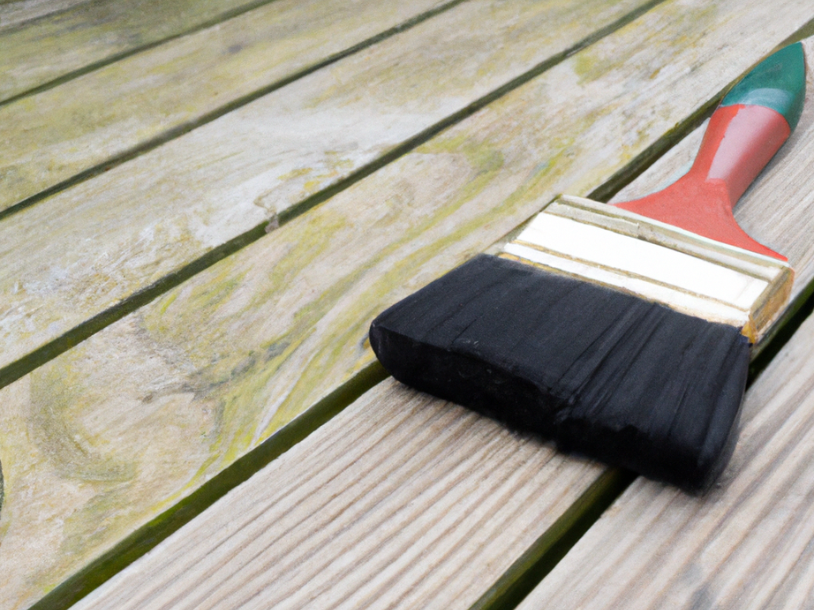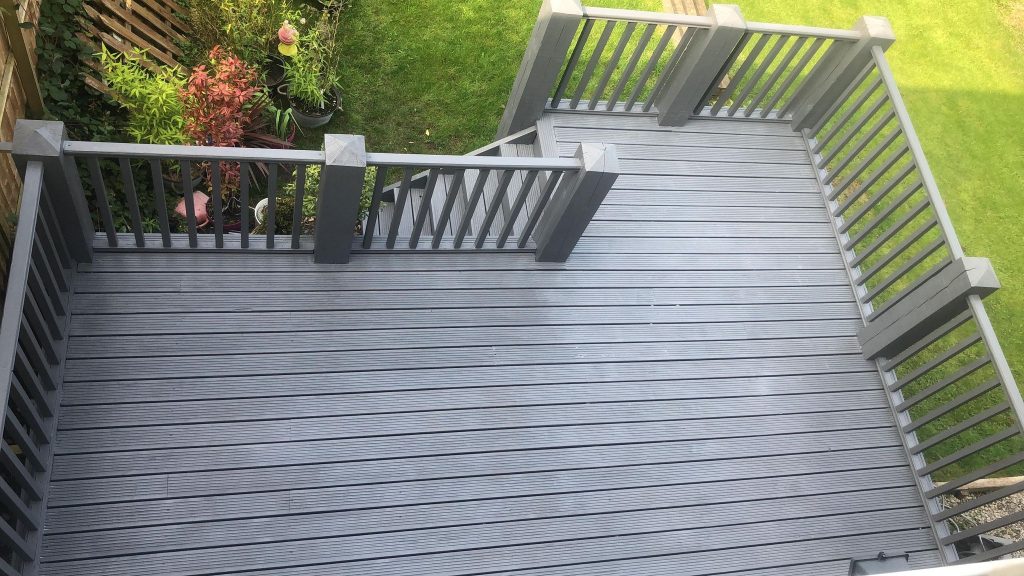
Nothing will spoil the look of your back garden like worn out decking. If it borders your lawn or is the first thing you see when you step outside, your deck deserves to look its best. But replacing decking is expensive, so what’s the solution?Simple, you need some of the best decking paint from Paintmaster.
Today we’re going to tell you all about the best decking paint, how it makes your decking look amazing, and how to get the best results when applying it.
KEY TAKEAWAYS
- There are a lot of types of decking paint to choose from – each with their own pros and cons.
- The best decking paint protects the surface of your decking from rot and mildew.
- Follow our painting guide for the best results.
Can you Paint Decking?
You certainly can! Painting your decking, and other wooden surfaces, is a simple and cost-effective way to freshen up your garden. Plus, if you use the right product, you’ll protect the decking too, meaning it will look great for a long time.
But like with many exterior painting jobs, there are a few choices to make. The type of paint you use, the colour, and the texture are all factors to keep in mind. Don’t worry, we’ll explain the pros and cons, so you can order decking paint with confidence.
What is Decking Paint?
Most decking paint can be split into two major categories.
Water-based decking paint, also known as water-based Woodstain, absorbs into the wooden surface, protecting it from rot and mould for years. It will also prevent the wood from cracking and splitting naturally, providing long-term protection for your decking.
Water-based paints are easy to apply. This makes them an ideal choice for beginners. Professional painters used to avoid water-based paints, as a while back they weren’t as reliable as another type we’ll discuss in a moment. However, nowadays water based Woodstain is an excellent choice for both amateurs and professionals, meaning the one you use is up to personal preference.
Our water based Woodstain is available in Clear, Dark Green, and Dark Brown.
The other type of Woodstain is oil based woodstain. Perfect for any wooden surface, our oil based Woodstain bonds to the surface, and the oily formula makes it resist water well. Standing water is the most common cause of rot for decking, and it can wear away paint and stain too, so preventing the water from soaking in gives the wood extra longevity.
Oil based paint is naturally glossier than water based or acrylic (more about that later), so if you want your decking to shine in the sunlight, oil-based paint with a high sheen is right for you.
This type of Woodstain is trickier to apply, but the results speak for themselves. It also has a strong odour, although this is less noticeable when using it outside. Plus it’s safe for pets once it’s dried.
Our oil based Woodstain is available in Clear, Dark Green, and Dark Brown.
That was a lot of info, so here’s a list of their pros and cons:

Water based Woodstain Advantages
- Easy to apply
- Protects the surface
- Low odour
- Safer for pets
- Dries quickly
Water based Woodstain Disadvantages
- Doesn’t protect for as long as oil based
- Lower sheen
Oil based Woodstain Advantages
- Protects for longer
- Higher sheen
- Naturally water resistant
- Safe for pets
Oil based Woodstain Disadvantages
- Not beginner friendly
- Strong odour
- Takes longer to dry
What is the Best Decking Paint?
A simple question, but not one with a simple answer. We can’t say definitively ‘this is the best decking paint’ because Woodstain isn’t the only way to preserve your decking.
As with many painting projects, there is an acrylic option. For the boldest colours, acrylic paint is often the way to go. Decking paint is no different.
Our acrylic satinwood paint is perfect for wood and metal surfaces. It has a mid-sheen finish, meaning it reflects some light but isn’t dazzling in direct sunlight. This makes it ideal for decking that sees a lot of light during the day.
It’s a water-based paint, meaning it protects the surface well, meaning you won’t need to paint it again for a few years. As mentioned earlier, water-based paint is easy to apply too, so it’s a good choice if you’re new to exterior painting.
That’s not the only acrylic paint option either!
Our acrylic shed and fence paint can also be used for decking. It still protects the surface but allows the natural woodgrain to show through the layers of paint. If you want a colourful look for your decking but don’t want it to look too plasticky, this is the perfect choice for you.
We also supply acrylic gloss decking paint if you prefer a higher sheen level on your wood surfaces.
The best part about acrylic decking paint is the range of colours available. Other options are limited in this respect; if you want to be bold with your garden, you can choose reds, greens, blues, and everything else in between.
That’s because our acrylic decking paint is part of our Colour System. Simply enter any British Standard or RAL code at checkout and we’ll mix any colour you can imagine. Whatever your vision for your garden, we can help make it a reality.
Decking Painting Guide
Now that we understand all the different types of decking paint, and which one is best for you, it’s time to get painting!
As always, there’s some prep and cleaning involved, so make sure you have plenty of time set aside for the full project. Larger exterior painting jobs like this are best left for spring or summer, when the weather is much easier to predict. Strong winds and cold weather can ruin the finish of your paint as much as an unexpected shower!
We recommend having everything you need ready for each step before you begin. Here’s a list of what you’ll be using:
- Decking Paint
- Wood Preserving Primer
- Jetwash/Sponge and Water
- Decking Cleaner
- Rollers/Brushes
- Plastic Sheeting
- Painters’ Tape
- Paint Scraper*
*Needed only if the surface has been painted previously.
STEP 1 – How to Prepare Decking for Painting
Before you begin, you should thoroughly examine the surface of your decking. Any chipped wood or splinters should be repaired or removed beforehand. Paint will do a lot to rejuvenate your deck, but gaps and split wood will show through, and often stand out more when the surface is freshly painted.
You should also replace any rusty or exposed nails. This isn’t just for safety; shiny new nails won’t stand out sharply when all have been painted over. You’ll be able to check the surface more thoroughly after step 2, but an initial examination can save you a lot of time.
Next, if the decking has been painted before, use a paint scraper to remove the previous layer. Then, sand down the wooden surface in the direction of the boards (this only works on flat decking, not any with grooves). This may seem like a time sink, but your paint will bond better to the exposed wood, and won’t be able to cling to previous layers of paint and/or primer, ruining the overall finish.
STEP 2 – How to Clean Decking
This is the most important step. Any dirt, grime or mould on the wooden surface will affect the look of your decking even after multiple coats of paint, so you should endeavour to remove as much as possible before adding primer or paint.
The easiest way to clean your decking is using a jetwash. This will blast away any dirt and old paint. Some jet washers can also be filled with decking cleaner to make it even easier, ensure you confirm this is recommended for your washer before you try it.
You should then apply deck cleaner to the surface, scrubbing thoroughly with a sponge or cloth. This will remove the mildew and mould that has built up. If you clean your decking regularly, and remove standing water often, there shouldn’t be much to remove. Once the surface is covered, rinse with a hose or jetwash on its lowest setting and leave to dry for 24 hours.
STEP 3 – How to Apply Primer to Decking
You may be tempted to skip priming, but it’s an essential part of the painting process.
Use your tape to mark out the area you’ll be priming. This will prevent primer getting where it shouldn’t and give you those professional sharp edges when it’s time to paint. If you have a large deck, you can also split it into sections to make the job more manageable, just be sure to remove tape and overlap the layers when needed.
A quality wood-preserving primer will bond to the cleaned wood of your decking, giving the paint a better surface to cling to when applied. It also adds an extra layer of preservation. If your decking is prone to mould, rot, or mildew, adding primer will make it less likely to form in the future.
STEP 4 – How to Paint Decking
Now for the fun part.
Once your primer has dried, mark out the edges with some fresh tape and get ready to paint.
If you have smooth decking, without grooves, a paint roller is the best way to apply your decking paint. If your decking is groovy, a long-bristled brush will do the trick. Be sure not to overload your brush or your paint will pool between the grooves.
When painting, start from the corner and move in the direction of the woodgrain. This will give you the least resistance and help you keep each layer the same thickness. If there are any small cracks or dents, use a little extra paint to fill them in.
PAINTMASTER TOP TIP – Paint your decking in the shade as much as possible, any areas in direct sunlight will dry faster, and make the surface look patchy!
Depending on what type of decking paint you’ve chosen, you’ll need either 1-2 or 2-3 layers. Check the paint tin for our recommendation. Leave each layer to dry completely before you start the next.
STEP 5 – Admire your Work
When the final layer has dried, and you’ve removed all the tape and tools, take a step back and admire your freshly painted decking. How does it look?
Remember that, depending on what colour and sheen level you chose, it’ll look different throughout the day, so be sure to look out of the window whenever you get chance.
We also recommend saving any paint you have left for future touch-ups.
The UK’s Most Trusted Paint Supplier
Painting decking is a fun task for both amateur and professional painters, and the results speak for themselves! There are a lot of types of decking paint to choose from, so you can experiment with new blends and shades in the future.
We hope our guide was helpful, check out our blog for more information and advice about both interior and exterior painting.
Or, if you have any questions about us or our products, please get in touch.
We look forward to hearing from you.
FAQ's
Can you paint over old deck paint?
Painting over old deck paint is okay if the paint is still in good condition, however if the paint is flaking, peeling or cracked then you should use sandpaper to remove the old paint before repainting it. This is to ensure that there is a smoother finish with your new paint and helps it last longer.
Do I need to pressure wash deck before painting?
Any dirt, grime or mould on the wooden surface will affect the look of your decking even after multiple coats of paint, therefore it is essential that you thoroughly clean your deck before painting. A jet wash is the easiest and quickest way of removing these things and can even benefit you by getting into the gaps and corners of the decking. However it is not a necessity to use a jet wash as you can scrub the deck by hand using sandpaper and and brush, but bare in mind this will take a lot longer.
Do I need to sand decking before painting?
Wooden Decking Boards often expand and contract throughout the year due to changes in weather and temperature, which can result in wood fibres becoming free, like splinters. Sanding your deck before painting, to remove any of those splinters, is crucial for an attractive smooth finish.
How long does deck paint last?
If you look after your decking and correctly maintain it then decking paint can last up to 10 years. For it to last this long we would advice you to make sure that you regularly clean your deck and remove any sitting water. As well as this if you add 1 coat of deck stain every 2-3 years then the paint should last for around 10 years before needing to repaint your decking.
Is it better to paint a deck or stain it?
Decking paint creates a barrier that protects the wood from the elements weather that is rain, wind, or sunlight. This is on top of the fact that with your paint you have more of a choice of what colour you would like your decking to be, means that if you had to choice one we would recommend you paint your deck instead of staining it.
Is it better to paint decking with a roller or brush?
For any corners or fiddly gaps in your decking, a paint brush helps you paint into those areas with a lot more control, however painting the entire deck with a brush would be very time consuming therefore we would recommend using a paint roller over large areas to get the job done quicker.
